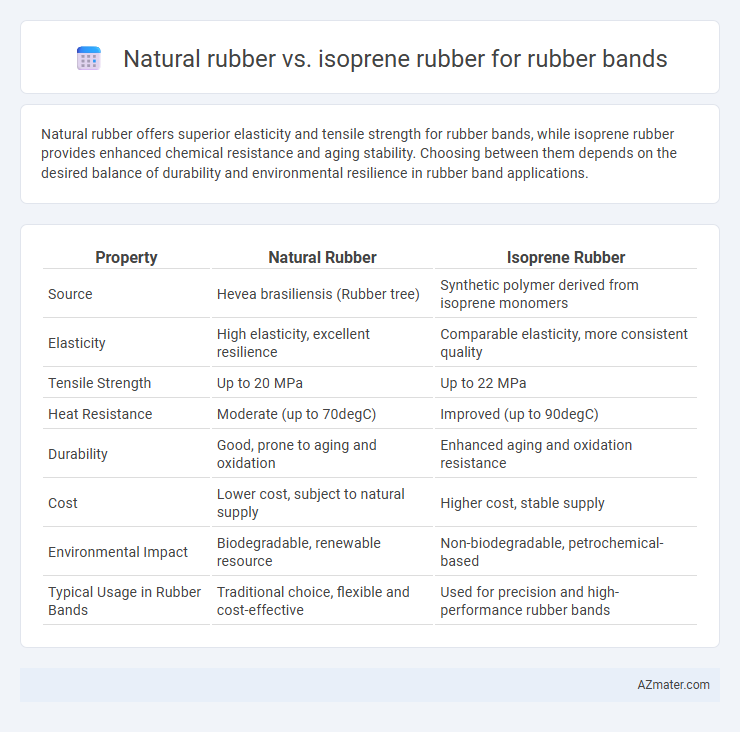Natural rubber offers superior elasticity and tensile strength for rubber bands, while isoprene rubber provides enhanced chemical resistance and aging stability. Choosing between them depends on the desired balance of durability and environmental resilience in rubber band applications.
Table of Comparison
| Property | Natural Rubber | Isoprene Rubber |
|---|---|---|
| Source | Hevea brasiliensis (Rubber tree) | Synthetic polymer derived from isoprene monomers |
| Elasticity | High elasticity, excellent resilience | Comparable elasticity, more consistent quality |
| Tensile Strength | Up to 20 MPa | Up to 22 MPa |
| Heat Resistance | Moderate (up to 70degC) | Improved (up to 90degC) |
| Durability | Good, prone to aging and oxidation | Enhanced aging and oxidation resistance |
| Cost | Lower cost, subject to natural supply | Higher cost, stable supply |
| Environmental Impact | Biodegradable, renewable resource | Non-biodegradable, petrochemical-based |
| Typical Usage in Rubber Bands | Traditional choice, flexible and cost-effective | Used for precision and high-performance rubber bands |
Introduction to Natural Rubber and Isoprene Rubber
Natural rubber, primarily sourced from Hevea brasiliensis latex, exhibits excellent elasticity, resilience, and tensile strength, making it ideal for manufacturing durable rubber bands. Isoprene rubber, a synthetic elastomer chemically identical to natural polyisoprene, offers consistent quality, enhanced purity, and resistance to aging and oxidation, which improves the lifespan of rubber bands. The choice between natural and isoprene rubber impacts elasticity, durability, and environmental factors in rubber band production.
Chemical Composition and Structure
Natural rubber is primarily composed of poly(cis-1,4-isoprene), a polymer with high molecular weight and a nearly cis-1,4 structure, giving it excellent elasticity and tensile strength ideal for rubber bands. Isoprene rubber, a synthetic variant, closely mimics the chemical composition of natural rubber with a cis-1,4-polyisoprene structure but allows for controlled molecular weight distribution and fewer impurities. The subtle differences in polymerization methods influence the uniformity and performance characteristics in rubber bands, with natural rubber generally offering superior resilience and isoprene rubber providing enhanced consistency and resistance to aging.
Raw Material Sources and Sustainability
Natural rubber, derived from the latex sap of Hevea brasiliensis trees, offers a renewable and biodegradable source for rubber bands, supporting sustainable forestry practices and reducing reliance on fossil fuels. Isoprene rubber, a synthetic alternative produced primarily from petroleum-based feedstocks, provides consistent quality but poses challenges in terms of environmental impact due to its non-renewable raw material sources and less favorable biodegradability. Choosing natural rubber enhances sustainability by utilizing a renewable resource with a lower carbon footprint, whereas isoprene rubber emphasizes performance but may contribute to greater ecological concerns.
Production Processes
Natural rubber for rubber bands is derived from latex harvested primarily from Hevea brasiliensis trees, involving coagulation, drying, and milling processes to produce strong, elastic sheets. Isoprene rubber, a synthetic alternative, is produced through polymerization of isoprene monomers using catalysts in controlled industrial reactors, resulting in consistent molecular weight and purity. The natural rubber process depends on biological extraction and natural curing, whereas isoprene rubber production emphasizes chemical synthesis and precision control for uniformity.
Mechanical Properties Comparison
Natural rubber exhibits superior tensile strength and elasticity compared to isoprene rubber, making it highly effective for rubber bands requiring extensive stretch and recovery. Isoprene rubber offers better resistance to UV degradation and ozone, enhancing durability under environmental stress but with slightly lower mechanical resilience. The choice between the two depends on balancing mechanical strength with environmental stability for specific rubber band applications.
Elasticity and Performance in Rubber Bands
Natural rubber exhibits superior elasticity and resilience compared to isoprene rubber, making it ideal for rubber bands requiring high stretchability and quick recovery. Isoprene rubber, while similar in chemical structure, offers enhanced resistance to oxidation and aging but slightly lower elasticity, which may reduce performance in applications demanding extensive stretching. Rubber bands made from natural rubber maintain their shape and elasticity longer under repeated stress, providing better overall performance in everyday use.
Durability and Resistance to Aging
Natural rubber offers excellent elasticity and high tensile strength, making it durable for rubber bands under normal use. Isoprene rubber closely mimics natural rubber's molecular structure, providing superior resistance to ozone, UV light, and oxidative aging, which enhances long-term durability. For applications requiring prolonged exposure to environmental factors, isoprene rubber bands maintain flexibility and strength better than natural rubber counterparts.
Cost Efficiency and Economic Considerations
Natural rubber offers higher elasticity and tensile strength at a lower raw material cost, making it more cost-efficient for mass production of rubber bands. Isoprene rubber, while providing superior uniformity and resistance to aging, comes with a higher manufacturing cost that can impact overall economic viability. For large-scale rubber band manufacturing, natural rubber remains the preferred choice due to its favorable balance between quality and cost efficiency.
Environmental Impact and Biodegradability
Natural rubber, derived from rubber tree latex, exhibits superior biodegradability and lower environmental impact compared to synthetic isoprene rubber, which is petrochemical-based and less eco-friendly. The biodegradation rate of natural rubber promotes reduced landfill accumulation and minimizes toxic residue release, enhancing its sustainability credentials. In contrast, isoprene rubber's resistance to microbial breakdown results in prolonged environmental persistence, raising concerns over waste management and ecosystem disruption.
Choosing the Right Rubber for Rubber Bands
Natural rubber offers superior elasticity and tensile strength, making it highly suitable for durable rubber bands requiring flexibility and resilience. Isoprene rubber, a synthetic alternative, provides excellent aging resistance and consistent performance in varying temperatures, ideal for rubber bands exposed to harsh environmental conditions. Selecting the right rubber depends on balancing natural rubber's high elasticity with isoprene rubber's enhanced stability and longevity for specific rubber band applications.

Infographic: Natural rubber vs Isoprene rubber for Rubber band
 azmater.com
azmater.com